
Following an early history commencing in 1919, when “torpedo vessel destroyers” were first organized as squadrons, the squadron that operated in World War II appeared in 1936 when the eight Farragut-class 1,500-tonners were formed as DesRon 20 with 1,850-ton Porter-class destroyer leader Phelps (DD 360) as flagship.
On 7 December 1941, the squadron under the command of Capt. A. R. Early was nested by division at anchor in Pearl Harbor. At 0751, ready-duty destroyer Monaghan received orders to join the flush decker Ward off the harbor’s entrance, where the latter had just sunk an unidentified submarine. In the next minutes, however, Japanese planes commenced their attack and as Monaghan led DesDiv 2 in getting under way, she rammed, depth charged and sank another midget submarine inside the harbor. Lying alongside tender Dobbin (AD 3) “in cold iron,” meanwhile, DesDiv 1 could only open antiaircraft fire at first, but Phelps, Macdonough and Worden all were credited with splashing enemy planes. Eventually, the squadron formed up with carrier Enterprise (CV 6) at sea before reentering the harbor the following day.
World War II Operations of the destroyers
originally attached to Destroyer Squadron 1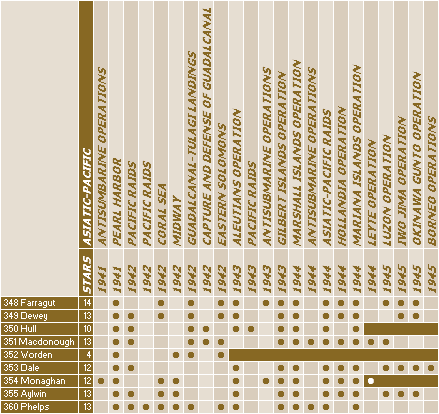
In December, DesRon 1 was attached to VAdm. Wilson Brown, Jr.’s Task Force 11, Lexington (CV 2) with cruisers Indianapolis (CA 35), Chicago (CA 29) and Portland (CA 33). On the 14th, after delays due to bad weather, the task force cleared Pearl Harbor as a diversion for an expedition under RAdm. Frank J. Fletcher in Saratoga (CV 3) to relieve Wake Island, but was recalled on 22 December when it became apparent that Wake would fall. En route home, Monaghan, Dale and Aylwin damaged an enemy submarine.
On 31 December, Admiral Chester W. Nimitz assumed command of the Pacific Fleet with orders to defend vital military areas, halt the Japanese advance, keep open the lines of communication with Australia, and mount offensives with his available aircraft carriers. For the next eight months, DesRon 1 operated on the front line of the Pacific war.
On 23 January, the Japanese seized Rabaul on New Britain Island and began developing it into an important base from which Australia could be threatened. In response on 31 January, Task Force 11 under got under way with DesRon 1 less Farragut and Monaghan.

DesRon 1 in the Pacific, January-March 1942.
On 20 February, as the formation closed Rabaul from the east, eighteen land-based bombers attacked. In the Pacific war’s first major clash between opposing aircraft, Lexington fighters and task force AA fire splashed sixteen of the bombers. No ships were hit, but surprise was lost and Brown retired.
Two weeks later, on 6 March, however, Brown was again planning to attack Rabaul; this time from the Coral Sea with a force increased to two carriers, eight heavy cruisers and eighteen destroyers via the addition of Australian RAdm. John G. Crace’s ANZAC squadron and RAdm. Fletcher’s Task Force 17 built around Yorktown (CV 5). These plans changed quickly when news arrived on the 8th of enemy landings at Lae and Salamaua on Netherlands New Guinea’s northeast coast.
On 10 March, in the first US two-carrier operation against a common objective, 104 Lexington and Yorktown planes took off from the carriers’ position in the Gulf of Papua, crossed a pass in the 13,000-foot Owen Stanley Range and, “remembering Pearl,” surprised the invasion force, sinking three ships and damaging nine. It was “the best day’s work we have had,” President Roosevelt told British Prime Minister Winston Churchill.
Over the next month, while Yorktown remained in the South Pacific, Lexington and her task force returned to Pearl Harbor on 26 March for replenishment and repair, having steamed 38,000 miles since the declaration of war during an unprecedented 55 continuous days at sea. There on 2 April, RAdm. Aubrey W. Fitch relieved VAdm. Brown. On 15 April, the task force, again with DesRon 1 less Macdonough and Hull, cleared Pearl Harbor for another rendezvous with Yorktown in the Coral Sea on 1 May.

DesRon 1 in the Pacific, May-June 1942.
On 3 May, a small Japanese force seized Tulagi in the Solomon Islands to establish a seaplane base. Concurrently, eleven transports—covered by the light carrier Shoho, four heavy cruisers, and a destroyer—prepared to depart Rabaul for Port Moresby, New Guinea, while large carriers Shokaku and Zuikaku and their screen waited to strike from further north. On the morning of the 4th, Yorktown aircraft attacked the Tulagi invasion force. On the 6th, the two American task forces combined under Fletcher. At daybreak on the 7th, Fletcher detached Admiral Crace with cruisers and destroyers to block the approaches to Port Moresby. He then turned his carriers north in search of the enemy.
Opening the Battle of the Coral Sea, two waves of Japanese planes missed Fletcher’s carrier force but heavily damaged Neosho (AO 23) and sank Sims. Yorktown and Lexington aircraft found and sank Shoho, however, causing the Port Moresby occupation force to turn back.
The battle continued on the 8th, when a Lexington scout plane spotted Shokaku and Zuikaku and planes from the two carriers scored three hits on Shokaku. In return, Japanese planes attacked and hit Yorktown and Lexington. Yorktown survived and “Lady Lex,” too, was making 25 knots until gasoline vapors ignited in a tremendous explosion. As fires raged out of control, Phelps launched five torpedoes to scuttle her. Phelps, Dewey and four DesRon 2 destroyers rescued more than 1,100 survivors. The Japanese also retired, however, and Australia remained secure.
On 16 May, DesRon 1 met RAdm. Halsey’s Task Force 16 with Enterprise and Hornet (CV 8) for a rapid return to Pearl Harbor. On the 28th, Phelps, Dewey, Worden, Monaghan and Aylwin sortied with Task Force 16 (Enterprise, Hornet, five heavy cruisers, six other destroyers and two oilers), now under RAdm. Raymond A. Spruance, on a mission to defend Midway Atoll against attack. RAdm. Fletcher with Yorktown joined them on 2 June. Scouting aircraft sighted the approaching Japanese Occupation Force on the 3rd.
During the Battle of Midway that followed on 4 June, the Japanese lost all four of their large carriers engaged while sinking Yorktown and destroyer Hull sailed with a fire support group.
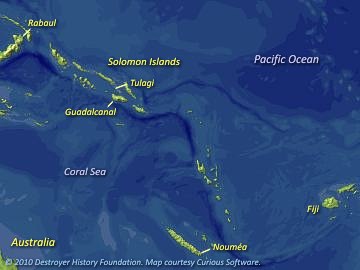
DesRon 1 in the Pacific, July-August 1942.
After rehearsals at Fiji, Marines landed Guadalcanal and Tulagi on 7 August to capture the airfield under construction there. Opening the operation, Dewey and Hull bombarded Guadalcanal’s landing beaches and later took up antisubmarine patrol around the transport area. When an enemy plane crashed the transport George F. Elliot (AP 13) and set her afire, Dewey rescued 40 survivors and Hull sank her.
Japanese carrier forces appeared two weeks later. At the Battle of the Eastern Solomons on the 24 August, their aircraft damaged Enterprise but failed to detect Saratoga, whose planes sank carrier Ryujo and damaged seaplane tender Chitose. On the 31st, however, Japanese submarine I-26 torpedoed Saratoga, which retired to Tongatabu on 6 September and to Pearl Harbor for repairs on the 23rd. There, DesRon 1 destroyers remained or sailed to the West Coast for overhaul. Operating on independent assignment, meanwhile, Monaghan damaged both screws on 17 November at Nouméa but was able to make Pearl Harbor, where she remained under repair until 21 February 1943.
Concurrent with their Midway operation in June 1942, the Japanese had invaded Kiska in the Aleutian Islands and subsequently occupied Attu to the west. Admiral Nimitz finally responded on 12 January 1943. Before dawn that morning, Worden stood into Amchitka’s undefended Constantine Harbor to land an army advance security detail. On the way out, however, she grounded and sank. Boats from Dewey and transport Arthur Middleton (AP 55) rescued survivors, but fourteen men were lost. Amchitka was secured, meanwhile, and Aylwin, Dale and Monaghan soon arrived to join a blockade of Attu and Kiska commencing on 18 February.
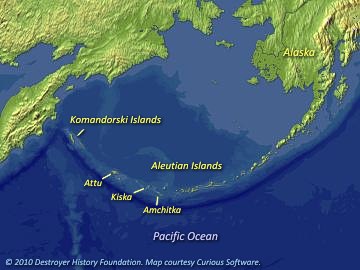
DesRon 1 in the Pacific, January-September 1943.
On the morning of 26 March, Dale and Monaghan joined DesRon 14 1,630-tonners Bailey and Coghlan in a scouting line with cruisers Salt Lake City (CA 25) and Richmond (CL 9), flagship of RAdm C.H. (“Sock”) McMorris, which intercepted a superior Japanese task force escorting an Attu-bound resupply convoy. The Battle of the Komandorski Islands that followed was the Pacific war’s only daylight surface action without intervention by aircraft or submarines. In desperation, while Dale stood by Salt Lake City, Admiral McMorris ordered Bailey, Coghlan and Monaghan to attack with torpedoes. To their amazement and relief, the enemy turned away and retired.
Back on the West Coast on 24 February, meanwhile, Capt. Brewer was detached as Commander, DesRon 1 and relieved on 28 March by Comdr. Ruthven E. Libby, who in April headed north with Phelps, Farragut, Hull, and Macdonough.
On 10 May, while patrolling off Attu, Macdonough collided with flush-deck destroyer-minelayer Sicard (DM 21) and had to return to Mare Island for repairs. On the 11th, the squadron’s seven remaining destroyers under now-Capt. Libby joined RAdm Francis Rockwell’s Task Force 51 for the invasion of Attu (Operation LANDCRAB). Phelps opened the assault by leading landing craft through the fog into Holtz Bay. Offshore, Farragut, Hull and Macdonough maintained station with bombarding battleships Nevada (BB 36), Pennsylvania (BB 38) and Idaho (BB 42).
On the 12th, Farragut and Edwards attacked submarine I-31 but failed to sink her. On the 13th, Phelps and gunboat Charleston (PG 51) provided call fire support for troops ashore, and on the 22nd successfully evaded torpedoes during an attack by 19 “Betty” bombers. Japanese resistance ended on the 30th.
Next, Task Force 51 commenced blockading Kiska. On 22 June, Monaghan drove Japanese submarine I-7 on the rocks. Seizure of the island (Operation COTTAGE) began with a bombardment on 22 July. On the 26th, Monaghan and Aylwin joined a formation with battleships Mississippi (BB 41) and Idaho for a “Battle of the Pips” against a what turned out to be a phantom enemy task force. The Japanese completed their abandonment of the island in secret on the 28th, which US forces discovered only when troops landed on 15 August.
After remaining on station in the Aleutians into September, the squadron returned to the West Coast for a brief overhaul.
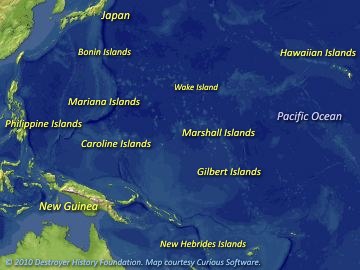
DesRon 1 in the Pacific, October-December 1943.
Meanwhile, the first of the large Essex-class carriers had arrived at Pearl Harbor. There, on 5 August, VAdm. Spruance assumed command of the new Fifth Fleet and prepared to drive westward across the Pacific. After a first strike on Marcus Island on 1 September and one on the Gilbert Islands on 18–19 September, Hull joined the screen for a 5–6 October strike on Wake Island by planes from Essex (CV 9), Yorktown (CV 10), Lexington (CV 16), Independence (CVL 22), Belleau Wood (CVL 24) and Cowpens (CVL 25).
The entire squadron assembled for the Gilbert Islands operation (Operation GALVANIC) in November. Departing from Espiritu Santo in the New Hebrides Islands (Vanuatu), Farragut, Monaghan and Aylwin screened RAdm. Harry. W. Hill’s escort carriers Sangamon (CVE 26), Suwannee (CVE 27), and Chenango (CVE 28) for the invasion of Tarawa on the 20th. That same day, Dewey and Hull screened RAdm. Robert C. (“Ike”) Giffen’s battleships Idaho and Pennsylvania and cruisers Minneapolis and San Francisco (CA 38) during the assault on Makin Island, where Phelps and Macdonough were stationed as control ships on the assault craft line of departure.
With the Gilberts secure, on 8 December, Capt. Ephriam R. McLean, Jr. relieved Capt. Libby as ComDesRon 1.
On 21 December the squadron returned to San Francisco and then dispersed to West Coast shipyards for overhaul. Reassembled at San Diego, it departed on 13 January 1944, and cleared Pearl Harbor on the 22nd for the Marshall Islands (Operation FLINTLOCK).

DesRon 1 in the Pacific, January-February 1944.
On 31 January, Farragut, Dale and Monaghan screened carriers Sangamon, Suwannee, and Chenango while Macdonough and Aylwin escorted transport and landing craft, and Dewey and Hull operated with an Attack Force Reserve. Phelps, with her heavy battery of 5-inch guns, drew the special assignment of covering mine clearance operations in passages into the lagoon at Kwajalein Atoll. There, she became the first United States surface combatant ship to anchor in pre-war Japanese territorial waters. The following day, joined by La Vallette and Johnston, she marked the line of departure for the Marine landings on Roi and Namur Islands.
Kwajalein was secured by the 5th, and the squadron anchored in the Fifth Fleet’s new advanced base at Majuro Atoll on the 7th. On the 16th, Phelps, Macdonough and minesweeper Sage (AM 111) sank submarine RO-40.
On 19 February, the squadron repeated its performance in the capture and occupation of Eniwetok Atoll (Operation CATCHPOLE) where, on the 22nd, Macdonough, Monaghan and Aylwin delivered plunging fire in support of the final landings on Parry Island.
On 7 March, Capt. McLean shifted his flag to Dewey as Phelps departed for the West Coast and reassignment to DesRon 3.
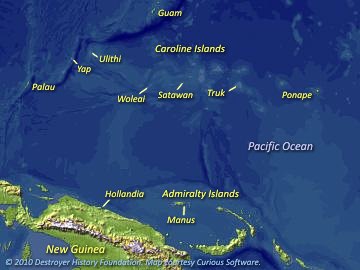
DesRon 1 in the Pacific, March-May 1944.
On 22 March, the squadron less Hull plus 2,100-tonners McDermut and later Mertz sortied with RAdm. A. E. Montgomery’s Task Group 58.2, including carriers Bunker Hill (CV 17), Hornet (CV 12), Monterey (CVL 26) and Cabot (CVL 28), to strike Palau, Yap, Ulithi and Woleai on 30 March and 1 April, returning to Majuro on the 6th.
After Hull rejoined on the 10th, the squadron stood out again on the 13th to deliver air strikes on enemy positions in the Hollandia and neighboring areas of New Guinea’s north coast. There, DesRon 1 destroyers provided fire support for the landings that commenced General Douglas A. MacArthur’s jungle campaign. Continuing on, carrier aircraft struck the major Japanese base at Truk in the Caroline Islands on 29 April, and also hit Satawan and Ponape before the formation returned to Majuro on 4 May.
For the assault on the Mariana Islands (Operation FORAGER), DesDiv 1 (Dewey, Hull and Macdonough) covered minesweeping and under water demolition team operations at Saipan beginning on 13 June, and remained on patrol during the initial landing on the 15th. During the Battle of the Philippine Sea on the 19th, it was again attached to RAdm. Montgomery’s Task Group 58.2 in the screen of Bunker Hill, Wasp (CV 18), Monterey and Cabot. Concurrently, DesDiv 2 (Farragut, Dale, Monaghan and Aylwin) conducted a range of screening, patrol and shore bombardment assignments.
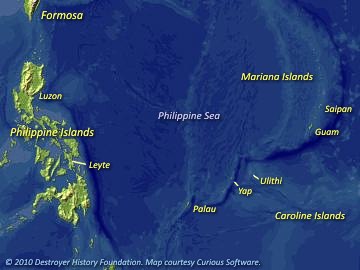
DesRon 1 in the Pacific, June-December 1944.
On 8 August, Capt. McLean was detached from command of DesRon 1; Capt. Preston V. Mercer assumed command on the 14th.
For the invasion of the Philippines, Macdonough joined DesRon 49 in escorting transports from Manus to Leyte on both 14 October and 3 November. Other destroyers of the squadron, meanwhile, returned to the West Coast. There, after modifications, inclining experiments conducted on Dewey and Aylwin indicated their stability had been reduced.
Back in the war zone, Dewey, Aylwin, Monaghan and Hull departed the advanced base at Ulithi on 10 December in the screen of Capt. J. T. Acuff’s Task Group 38.0, a logistics support group for Adm. Halsey’s Third Fleet that included twelve oilers and five escort carriers transporting replacement aircraft. East of Luzon on the 18th, the formation was overtaken by a typhoon. In winds exceeding 100 knots, squadron flagship Dewey rolled and hung at more than 75 degrees; task group flagship Aylwin also laid over at 70 degrees for 20 minutes. Both ships survived. Monaghan, Hull and 2,100-tonner Spence were lost, however, with 790 officers and men. Rescue ships found a mere 62 Hull survivors scattered over more than 60 miles of ocean and only six from Monaghan.
After the storm, Farragut and Macdonough remained at sea with Task Group 38.0 while Dewey and Aylwin returned to Ulithi for repairs. There on 7 January 1945, Capt. Mercer shifted his flag to Dale but was detached as ComDesRon 1 on the 30th, when Capt. J. F. Walsh assumed temporary command.
In February, Dewey, Farragut, Dale and Aylwin continued operating with logistics support echelons during the assault on Iwo Jima in the Bonin Islands (Operation DETACHMENT).
On 1 March, the squadron was reassigned as Destroyer Division 10 of Destroyer Squadron 5, and continued operations off Okinawa (Operation ICEBERG) in April. Dale also saw action off Borneo. Thereafter, all five ex-DesRon 1 veterans returned to the East Coast where they were decommissioned at New York Navy Yard in October and sold for scrapping. Collectively, the squadron’s original nine destroyers earned 103 service stars during the Asiatic-Pacific campaign, 97 of them while attached to Destroyer Squadron 1.